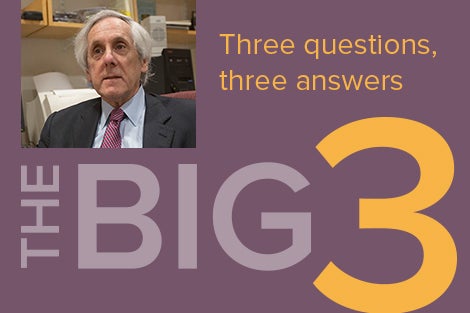April 19, 2016—April is National Distracted Driving Awareness Month. Jay Winsten is the Frank Stanton Director of the Harvard T.H. Chan School of Public Health’s Center for Health Communication and associate dean for health communication, which recently celebrated its thirtieth anniversary. He talks about the Center’s newest initiative—a campaign to prevent injuries and fatalities caused by “distracted driving,” which encompasses not only the use of smart phones while behind the wheel but also a broad array of other distractions.
A number of organizations and government agencies have produced graphic online videos highlighting the dangers of distracted driving. What will be different about this campaign?
The efforts to date have relied on a negative “don’t” message. While successful in raising public awareness of the problem—a crucial first step—these initiatives have not resulted in large-scale behavior change. In surveys, large majorities acknowledge that the problem is a serious one. However, they reject the idea that they themselves are at risk of causing a distracted driving crash, because they believe they have excellent multi-tasking skills. So, they watch with rapt attention the graphic videos of reenacted crashes, but they dismiss the message because, “That’s not me.”
At the same time, however, surveys have found that a large majority is fearful of becoming a victim of a distracted driving crash caused by someone else. In a recent survey conducted by Allstate, 46% of young adults said that, as a result of that fear, they tend to drive “defensively.” Other surveys have found similar results. We see this defensive driving finding as providing an opening to build on. That is, if many young adults already drive defensively, they may respond positively to a campaign that encourages them to aspire to an even higher level of defensive driving skills.
With this in mind, our strategy is to promote “attentive driving.” We will focus initially on “scanning for surprises” to maintain “situational awareness.” Situational awareness (SA) is defined as a state of readiness to respond to potential safety threats in the driving environment. Loss of SA has been shown to be a contributing factor in the 90% of traffic crashes caused by human error. The importance of situational awareness has been widely recognized for many years in aviation and in numerous other fields. But in traffic safety, the concept’s importance has not been widely acknowledged or adopted outside of a core group of researchers. We want to change that, through a national media campaign and a grassroots community-based effort.
Instead of telling drivers what not to do, we want to inspire them to improve their situational awareness skills, starting with systematic scanning, so that they can protect themselves from other drivers, especially in high-risk situations. We think this will also have a spillover effect on their own behavior, because they cannot maintain situational awareness when they themselves are distracted.
The Center launched the successful Designated Driver campaign in the U.S. in the late 1980s. What lessons from Designated Driver will you apply to the new campaign?
We learned that a positive, narrowly focused message advocating a specific, practical action can be highly effective, especially as part of a comprehensive strategy for addressing the problem. Our slogan emphasized taking care of friends: “The Designated Driver is the life of the party.” And our messaging was not anti-alcohol. “If you choose to drink, drink only in moderation, and choose a designated driver who doesn’t drink at all.” The campaign’s ultimate goal was to promote widespread adoption of a societal norm that “the driver doesn’t drink.”
You launched Designated Driver at a time when television was the leading advertising medium. How have you had to adapt to the new media landscape?
Back then, cable TV was in its early years and the Internet was not a factor. There were only three major networks. If your message was on networks during prime time, you could expect to reach 75% of the American public. Now, the media marketplace is much more fragmented and the attention span of the public is much shorter. That’s a problem for public health because trying to change social norms around behavior is a multi-year and even decades-long process. Look at tobacco.
With social media, sustainability is difficult. Even a breakthrough creative idea will not garner lasting attention. The Ice Bucket Challenge, for example, raised a tremendous amount of money for ALS [Amyotrophic Lateral Sclerosis, also known as Lou Gehrig’s Disease] research, but it only garnered worldwide attention for a month or two in the summer of 2014. The ALS Association re-introduced it last summer, but it received far less attention and raised much less money. The challenge is to create a sequential series of “peaks of synchronicity” of attention to an issue.
One of our goals with the distracted driving initiative is to experiment with new ways of developing a public health campaign in the 21st century—to reinvent the model of health communication to take into account the fragmented media marketplace and the public’s short attention span. We will be convening a working conference this fall to synthesize what is currently known about distracted driving and explore ways to translate research into messaging for policymakers and the public. A report will be issued following the conference that will lay the foundation for the campaign. We envision an approach that will be both media- and community-based, ranging from getting distracted driving messages into Hollywood scripts, as we did with the Designated Driver campaign, to enlisting kids as agents of change.
